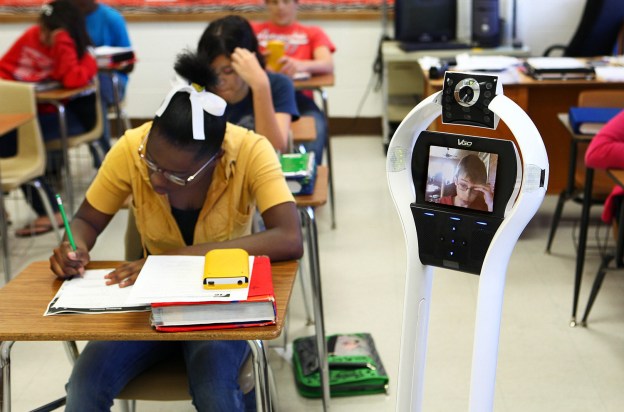 Lately I’ve been reading a lot about Devon Carrow, the elementary school student in upstate New York that is now attending school as a robot. Yes, I said robot. See, Devon has a rare, allergic reaction that has so far prevented him from going in person. But now with VGo, a 4ft. moveable device that kind of looks like a vacuum cleaner from “The Jetsons”, Devon is able to finally attend his classes. You may have seen the device featured in a series of Verizon commercials. Here’s what it looks like.
Lately I’ve been reading a lot about Devon Carrow, the elementary school student in upstate New York that is now attending school as a robot. Yes, I said robot. See, Devon has a rare, allergic reaction that has so far prevented him from going in person. But now with VGo, a 4ft. moveable device that kind of looks like a vacuum cleaner from “The Jetsons”, Devon is able to finally attend his classes. You may have seen the device featured in a series of Verizon commercials. Here’s what it looks like.
Devon is not the only student using the VGo to go to school though. Since 2011, students from New Jersey all the way to Wisconsin have been using it. One might say there’s a small army of robot students, if one were kind of an asshole.
I have to admit that my first reaction when I heard about this story was one of concern for Devon. After all, kids can be really cruel if you’re different – if you’re fat or skinny or have glasses or… wiring. I remember when I was about Devon’s age, our bald art teacher, Mr. Garcia came back from summer vacation with a full head of (someone’s) hair. Mr. Gar-chia as he was known from then on, was teased relentlessly. And he was an adult without circuitry. I can only imagine what kind of C-3PO puns would’ve been tossed his way if he came back with a motherboard.
No, seriously. If you’re able to get ‘Small Wonder’ out of your head, let me know how you did it. Please? I can’t sleep!
I guess if I really think about it, my worry stems from the fact that when I was Devon’s age, movies and television showed a future with robots and artificial intelligence that was dark and scary. Sure, there were some depictions of cuddly machines such as Number 5 from “Short Circuit”, Twiki from “Buck Rogers”, and who can forget Vicki from “Small Wonder”. (No seriously, if you’re able to get “Small Wonder” out of your head let me know how you did it. Please? I can’t sleep!)
But most of the examples we had were menacing. Like the movie where a cyborg from a post-apocalyptic future – who happens to look exactly like the ex-governor of California – travels back in time to eliminate a woman whose son will eventually grow up and lead the humans in a war against you guessed it, robots. Or the one where a young computer whizz kid – who happens to look exactly like Ferris Bueller – connects into a top secret super-computer with complete control over the U.S. nuclear arsenal, challenges the computer to a game of chess, which somehow initiates a countdown to World War 3 when the computer goes … rogue.
But the film that I immediately thought of when I heard of Devon is “D.A.R.Y.L.”. In this 80’s classic, it’s discovered that a nice young boy with a winning smile is actually a robot. What happens to D.A.R.Y.L. you ask? Well, the U.S. military, using all of its might, attempts to destroy him. I mean, they send frickin’ jets to the suburbs. No joke. Apparently, they too saw “The Terminator” and were not amused.
In so many of these stories the droids take over and Hal can’t be trusted. Eventually we all have to choose the red pill or the blue pill and then – Holy shit we’re all food for machines!!! Morpheus!

Their behavior is an inspiration to anyone who believes that technology’s ability to improve our lives is more powerful than its ability to ruin it, and should make technophobes everywhere chill out. Of course, that’s probably exactly what the growing Artificial Intelligence deep inside VGo wants us to think. Just wait until the kid hits puberty – then shit will really hit the fan.


